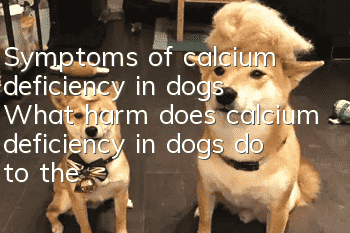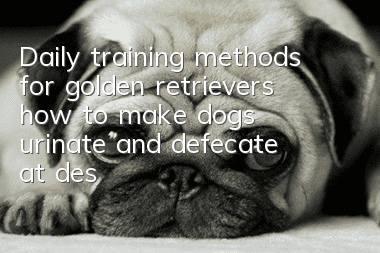Symptoms of calcium deficiency in dogs What harm does calcium deficiency in dogs do to the body?

General symptoms of calcium deficiency in dogs
1. The limbs and legs are deformed, and the legs will appear in an X-shaped or O-shaped shape.2. The dog’s toes will be separated, and it can be clearly felt that the dog is walking unsteadily because the soles of its feet are unstable.
3. There is obvious deformation in the dog’s leg joints, and the legs are distorted.
4. Sometimes dogs will drool due to calcium deficiency.
5. Dogs don’t like to move. They always feel weak and unwilling to walk or run.
6. There is also a lack of calcium when dogs are changing teeth, and the growth of deciduous teeth is slow, which will cause the deciduous teeth to fail to fall out in time, resulting in the phenomenon of double rows of teeth.
Like us humans, once dogs are deficient in calcium, their health will also be greatly threatened.
Generally speaking, if calcium supplementation is insufficient in young dogs, they may develop rib valgus and deformation of the wrist and elbow joints of the forelimbs. Small dogs are prone to "O" shaped legs, while large and medium-sized dogs may suffer severe deformation of the forelimbs. . If not detected in time and treated improperly, it may cause permanent paw splay or lameness. Calcium deficiency in adult dogs generally manifests as irritability, hot flashes, easy fractures, and laziness. The symptoms are somewhat similar to humans.
Symptoms of calcium deficiency in puppies
In addition, 2 to 3 months of age is an important period for the formation of intervertebral discs in puppies. If there is a lack of calcium at this time, some are susceptible to intervertebral discs. Breeds with the disease, such as Pekingese, Shih Tzu, Pug, Poodle, etc., will attack in adulthood, causing lifelong pain.When puppies grow to 4-6 months old, the deciduous teeth in the mouth begin to fall out, and the permanent teeth begin to grow. If there is a lack of calcium at this time, the deciduous teeth will not fall out, the permanent teeth will grow slowly, the enamel layer is thin, and the structure is not strong, and it is easy to have double rows of teeth or uneven permanent teeth. These dogs are prone to diseases such as bad breath and gingivitis in adulthood, which directly affects their life span.
Once dogs enter adulthood, dogs fed dog food do not need separate calcium supplements. Because during this period, the growth and development of the dog's bones and other organs has basically stopped, and the demand for calcium is very small. If they are breeding male dogs and pregnant and lactating female dogs, they still need to supplement a large amount of calcium, because semen, embryonic dogs and milk will cause a large amount of calcium to be lost from the body - if it cannot be replenished in time, the body will use it. Calcium in the calcium store causes osteoporosis.
Calcium deficiency symptoms in lactating bitches and elderly dogs
Postpartum lactating bitches will suffer from low blood calcium concentration And cause acute postpartum calcium deficiency. The symptoms include twitching of the limbs, stiffness of the whole body, body temperature that can rise above 40°C, and even cause coma and death. When large dogs reach the age of 8, theyEntering old age, dogs in old age have reduced calcium intake and increased calcium loss due to endocrine and other reasons. At this time, small dogs should be fed senior dog food, otherwise they should be artificially supplemented with calcium while maintaining a certain amount of exercise. Otherwise, it will cause osteoporosis and increase the incidence of bone spurs and fractures.Calcium supplementation method for dogs with calcium deficiency
The correct method of calcium supplementation is not only to take some dog-specific calcium powder according to the dosage, but also to eat some dairy products and cartilage and other foods, and reducing the intake of foods rich in vitamin A such as liver, are also conducive to calcium supplementation.Of course, if the dog has already shown symptoms of calcium deficiency, medication will be needed. It is recommended to choose some calcium carbonate and calcium lactate that are not too expensive, and at the same time inject vitamin D3, oral vitamin D2 and other supplements. Of course, if conditions permit, you can also choose some imported brands of pet calcium, because these products are more professional in comparison.
As for the specific amount of calcium supplement, it depends on the breed, size, age and calcium deficiency of the dog. It is best to go to the animal hospital to listen to the advice of a professional veterinarian.
Random articles
- After reading the advantages and disadvantages of Bago, you can decide whether to keep it or not!
- Why Pug is too fat? How to lose weight if Pug is too fat?
- What causes Bago's cough? What medicine should he take?
- What food is good for dogs to eat when they are vomiting? Come and get your dog’s stomach nourishing recipe
- Is it normal for Bug to snore? What is the reason for Bug to snore?
- Signs of an angry dog: You must avoid these situations
- What’s wrong with a dog foaming at the mouth? What should you do if a dog is foaming at the mouth?
- Golden Retriever Personality Characteristics Is the Golden Retriever good or bad?
- Things to note when bathing your dog. Under what circumstances should your dog not be bathed?
- What causes hair loss in dogs? Is it a skin disease that causes hair loss in dogs?



